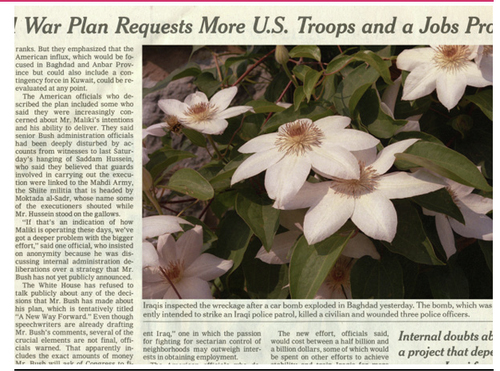“Newspapers are still with us, but the public role of at least the printed version is greatly diminished. We have effectively left the era of the printed page in which newspapers covered the land like rain. Yet, as the world becomes increasingly virtual and digital, newspapers take on an expanded role in our imaginations.”
“This exhibition will focus on currently working artists whose engagement with the material and content of newspapers gives us a window on its changing status. All of the artists grew up with newspapers as quotidian objects. They are perhaps the last generation to do so.”
— From the exhibit Burying the Lede
Your choice:
- Remix the New York Times
- Remix your Op-Ed essay
Remix = recontextualizing existing materials — an existing text, image, sound, or other material — in order to give it a new meaning. Watch “Everything is a Remix.”
This project requires your mindful, purposeful, and rhetorical integration of different  meaning-making modes—alphabetic text, sound, video, materiality, gesture/performance, color, animation, photographs, drawings—in order to achieve an intentional, rhetorical effect.
meaning-making modes—alphabetic text, sound, video, materiality, gesture/performance, color, animation, photographs, drawings—in order to achieve an intentional, rhetorical effect.
- View previous DePaul students’ remix projects.
- View remix projects from students at University of Maryland; see especially “the media tree”
- Can newspaper art, which is remixed & remediated, have a rhetorical effect?
Our remix process has three stages– take a moment to notice, even in passing, that it’s not that different than our essay-composing process:
- Planning worksheet
- Making your remix
- Reflecting & documenting your remix in a Statement of Goals & Choices
Step #1: Remix Worksheet assignment (500 words +/-):
- The product that you will create
- The processes or methodologies that will be (or could be) employed in composing that product
- The resources, materials, and technologies that will be (or could be) employed in the creation of that product
- The specific conditions in which your remix project will be experienced by readers – this involves planning and structuring the delivery, reception, and circulation of your remix project. Your guiding questions here: how do you want your reader to experience your remix? Why? What steps can you take to achieve those effects?
Step #2: Compose your remix
Step #3: Reflecting & documenting your remix in a Statement of Goals & Choices
